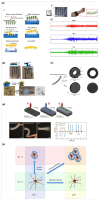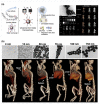The Current Trends of Biosensors in Tissue Engineering
- PMID: 32756393
- PMCID: PMC7459738
- DOI: 10.3390/bios10080088
The Current Trends of Biosensors in Tissue Engineering
Abstract
Biosensors constitute selective, sensitive, and rapid tools for disease diagnosis in tissue engineering applications. Compared to standard enzyme-linked immunosorbent assay (ELISA) analytical technology, biosensors provide a strategy to real-time and on-site monitor micro biophysiological signals via a combination of biological, chemical, and physical technologies. This review summarizes the recent and significant advances made in various biosensor technologies for different applications of biological and biomedical interest, especially on tissue engineering applications. Different fabrication techniques utilized for tissue engineering purposes, such as computer numeric control (CNC), photolithographic, casting, and 3D printing technologies are also discussed. Key developments in the cell/tissue-based biosensors, biomolecular sensing strategies, and the expansion of several biochip approaches such as organs-on-chips, paper based-biochips, and flexible biosensors are available. Cell polarity and cell behaviors such as proliferation, differentiation, stimulation response, and metabolism detection are included. Biosensors for diagnosing tissue disease modes such as brain, heart, lung, and liver systems and for bioimaging are discussed. Finally, we discuss the challenges faced by current biosensing techniques and highlight future prospects of biosensors for tissue engineering applications.
Keywords: biosensors; cell-based biosensors; label-free biosensors; organs-on-chips; tissue engineering; tissue/organ-based biosensors.
Conflict of interest statement
The authors declare no conflict of interest.
Figures




References
Publication types
MeSH terms
Grants and funding
LinkOut - more resources
Full Text Sources

